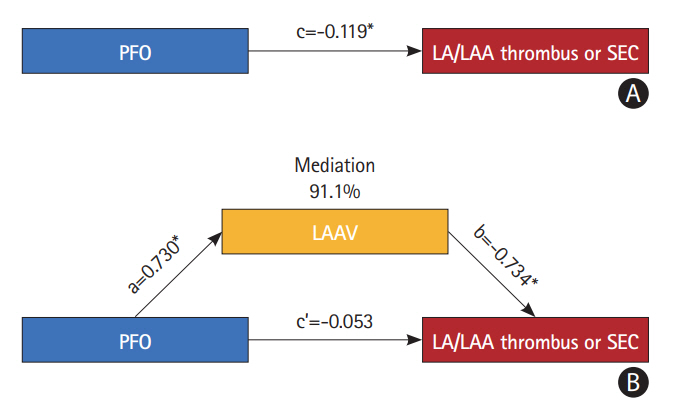J Stroke.
2023 Sep;25(3):417-420. 10.5853/jos.2023.01179.
Patent Foramen Ovale May Decrease the Risk of Left Atrial Thrombosis in Stroke Patients With Atrial Fibrillation
- Affiliations
-
- 1Department of Neurology, Yongin Severance Hospital, Yonsei University College of Medicine, Yongin, Korea
- 2Division of Cardiology, Severance Cardiovascular Hospital, Yonsei University College of Medicine, Seoul, Korea
- 3Department of Neurology, Yonsei University College of Medicine, Seoul, Korea
- 4Integrative Research Center for Cerebrovascular and Cardiovascular Diseases, Seoul, Korea
- 5Biostatistics Collaboration Unit, Department of Research Affairs, Yonsei University College of Medicine, Seoul, Korea
- KMID: 2546444
- DOI: http://doi.org/10.5853/jos.2023.01179
Figure
Reference
-
References
1. Fatkin D, Kelly RP, Feneley MP. Relations between left atrial appendage blood flow velocity, spontaneous echocardiographic contrast and thromboembolic risk in vivo. J Am Coll Cardiol. 1994; 23:961–969.2. Mügge A, Kühn H, Nikutta P, Grote J, Lopez JA, Daniel WG. Assessment of left atrial appendage function by biplane transesophageal echocardiography in patients with nonrheumatic atrial fibrillation: identification of a subgroup of patients at increased embolic risk. J Am Coll Cardiol. 1994; 23:599–607.3. Elgendy AY, Saver JL, Amin Z, Boudoulas KD, Carroll JD, Elgendy IY, et al. Proposal for updated nomenclature and classification of potential causative mechanism in patent foramen ovale–associated stroke. JAMA Neurol. 2020; 77:878–886.4. Baik M, Shim CY, Gwak SY, Kim YD, Nam HS, Lee HS, et al. Patent foramen ovale and risk of recurrence in stroke of determined etiology. Ann Neurol. 2022; 92:596–606.5. Bang OY, Park KM, Jeong DS. Occurrence of ischemic stroke in patients with atrial fibrillation receiving non-vitamin K oral anticoagulants: causes and prevention strategies. J Stroke. 2023; 25:199–213.6. Heo J, Lee H, Lee IH, Nam HS, Kim YD. Impact of left atrial or left atrial appendage thrombus on stroke outcome: a matched control analysis. J Stroke. 2023; 25:111–118.7. Vandenberk B, Morillo CA. Atrial fibrillation after transcatheter patent foramen ovale closure: to measure is to know. Heart Rhythm. 2022; 19:1421–1422.8. Baron RM, Kenny DA. The moderator-mediator variable distinction in social psychological research: conceptual, strategic, and statistical considerations. J Pers Soc Psychol. 1986; 51:1173–1182.9. Babur Guler G, Dogan AC, Kalkan AK, Demir AR, Uygur B, Birant A, et al. Does patent foramen ovale presence procure favourable outcomes in patients with severe rheumatic mitral stenosis? Int J Cardiovasc Imaging. 2021; 37:2871–2879.10. Kawano H, Honda Y, Johno T, Maruoka H, Nakanishi K, Saito M, et al. Antiplatelet therapy may be insufficient to prevent stroke recurrence before percutaneous patent foramen ovale closure. J Stroke. 2023; 25:307–310.
- Full Text Links
- Actions
-
Cited
- CITED
-
- Close
- Share
- Similar articles
-
- Post-Operative Multiple Thrombosis Associated with Patent Foramen Ovale: Embolic Stroke, Right Atrial Thrombi, Pulmonary Embolism and Deep Vein Thrombosis
- Patent Foramen Ovale, Old Patients, and Atrial Fibrillation
- Cardioembolic Stroke in Atrial Fibrillation-Rationale for Preventive Closure of the Left Atrial Appendage
- CT Diagnosis of Paradoxical Embolism via a Patent Foramen Ovale in a Patient with a Pulmonary Embolism and Prominent Eustachian Valve
- The Mechanism of and Preventive Therapy for Stroke in Patients with Atrial Fibrillation


